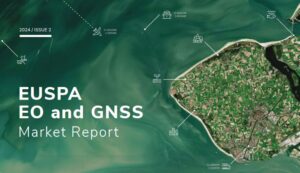The EUSPA EO & GNSS Market Report supports anyone who seeks to understand the markets of Satellite Navigation and Earth Observation technologies, make them part of their business plan or develop new downstream space applications.
Today, more than ever, the reliance on innovative solutions is crucial for business processes, well-being and addressing societal challenges. Earth Observation (EO) and Global Navigation Satellite System (GNSS) data play a pivotal role in several applications globally, answering the needs of many stakeholders, including citizens, businesses, governments, industries, international organisations, NGOs and researchers. As of 2023, the global revenues generated from GNSS and EO reached approximately €260 billion and €3.4 billion, respectively. Projections for 2033 anticipate substantial growth, with GNSS expected to reach €580 billion and EO nearly €6 billion.
EUSPA publishes the second edition of the “EUSPA EO and GNSS Market Report” to guide readers through some practical applications and benefits of downstream space technology. This comprehensive study features analytical insights into the evolving GNSS and EO markets, explaining how the latest global trends and drivers influence the uptake of space-enabled applications. Leveraging the latest data sources and advanced forecasting models, the report estimates the market evolution in terms of revenues (both for EO and GNSS), shipments and installed base (GNSS only) up to 2033.
The report assesses and analyses the use of EO and GNSS in diverse applications, explaining the added value and differentiators of the relevant EU Space Programme components: Galileo, EGNOS and Copernicus. The applications covered in the Market Report follow 15 market segments, encompassing: Agriculture; Aviation and Drones; Climate, Environment and Biodiversity; Consumer Solutions, Tourism and Health; Emergency Management and Humanitarian Aid; Energy and Raw Materials; Fisheries and Aquaculture; Forestry; Infrastructure; Insurance and Finance; Maritime and Inland Waterways; Rail; Road and Automotive; Space; Urban Development and Cultural Heritage.
Report highlights and trends
-The adoption of EO and GNSS across different segments is supported by overarching market drivers such as the digital transition, climate change, growing population, energy demand, supply chain challenges, and the rise of New Space entrepreneurship.
-GNSS market revenues, including device and service sales, are anticipated to more than double from approximately €260 billion in 2023 to nearly €580 billion in 2033. Consumer Solutions, Tourism and Health (including smartphones and fitness devices) and Road and Automotive (including in-vehicle systems and various on-board units) are the two mass-market segments accounting for the vast majority of the number of devices sold in a given year (shipments) or the number of devices currently in use (installed base). The other segments, including Agriculture, Urban Development and Cultural Heritage, Infrastructure and others, address mainly professional users and will significantly contribute to the overall GNSS market value.
-The EO market is set to expand from €3.4 billion in 2023 to nearly €6 billion by
2033, driven by the importance of improving the sustainability of human activity, improved service offering and increasing awareness of the potential use of EO.
Fast-growing segments such as Insurance and Finance will contribute to this increase, alongside more established ones like Climate, Environment, and Biodiversity; Agriculture; and Urban Development and Cultural Heritage.
“Considering today’s global context of rapid technological advancement, climate-related changes and ongoing geopolitical tensions […], this report underscores a pivotal insight. Amidst these challenges, Europe has the opportunity to harness the capabilities of EO and GNSS, fostering innovative solutions that positively impact society and play a role in shaping our collective future” concludes EUSPA Executive Director Rodrigo da Costa.
The report is available for download here








